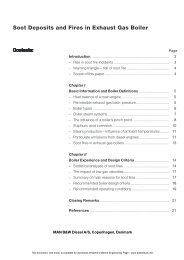Fire on Board the Liberian Passenger Ship Ecstasy, Miami, Florida ...
Fire on Board the Liberian Passenger Ship Ecstasy, Miami, Florida ...
Fire on Board the Liberian Passenger Ship Ecstasy, Miami, Florida ...
- No tags were found...
Create successful ePaper yourself
Turn your PDF publications into a flip-book with our unique Google optimized e-Paper software.
Factual Informati<strong>on</strong> 54 Marine Accident Reportcompanies have revised <strong>the</strong>ir SMS to include procedures for maintaining <strong>the</strong> ventilati<strong>on</strong>ducts in a fire-safe c<strong>on</strong>diti<strong>on</strong>.Qualitative Failure AnalysisRegulatory requirements. In 1988, <strong>the</strong> Coast Guard issued regulati<strong>on</strong>s(46 CFR 62, “Vital System Automati<strong>on</strong>” 43 ) requiring <strong>the</strong> use of a qualitative failureanalysis of certain automated systems, including propulsi<strong>on</strong> c<strong>on</strong>trol systems. In proposing<strong>the</strong> regulatory requirement that designers, manufacturers, and/or shipyards perform andsubmit system failure analysis, <strong>the</strong> Coast Guard stated that <strong>the</strong> use of advanced automati<strong>on</strong>technologies such as electr<strong>on</strong>ics and microprocessors made it increasingly difficult, “attimes impossible, for <strong>the</strong> Coast Guard, ship owners/operators, and classificati<strong>on</strong> societiesto evaluate safety.” The Coast Guard fur<strong>the</strong>r stated:The Coast Guard has chosen to propose safety performance standards that, to <strong>the</strong>greatest extent practicable, state <strong>the</strong> desired operati<strong>on</strong> or functi<strong>on</strong> withoutaddressing detailed design criteria…As an alternative to detail evaluati<strong>on</strong>, <strong>the</strong>Coast Guard proposes (to require) a failure analysis of <strong>the</strong> design and a selfcertificati<strong>on</strong>of design compliance to certain…standards. [This process]emphasizes <strong>the</strong> resp<strong>on</strong>sibility of <strong>the</strong> parties most familiar with any automati<strong>on</strong>system, i.e., <strong>the</strong> designer and manufacturer, to evaluate and certify <strong>the</strong> safety of<strong>the</strong> system. It also provides an evaluati<strong>on</strong> means that is suited to technologicalchanges. In most cases, <strong>the</strong> failure analysis will identify a preferred fail-safe state.Systems that would be required to be independent, that is, have arrangements thatprovide a level of safety and reliability equivalent to complete duplicati<strong>on</strong>,include:• C<strong>on</strong>trols systems• Alarms and instrumentati<strong>on</strong> (m<strong>on</strong>itoring systems)The IMO subsequently adopted regulati<strong>on</strong>s requiring that a failure modes andeffects analysis (FMEA) 44 be performed for <strong>the</strong> machinery and c<strong>on</strong>trol systems of highspeedvessels. 45 The IMO and classificati<strong>on</strong> societies presently do not require <strong>the</strong> use ofFMEA for passenger vessel propulsi<strong>on</strong> system designs. 4643 Subpart 62.10 defines system as an arrangement of elements that interact to perform a specificfuncti<strong>on</strong> and vital system as that which is essential to <strong>the</strong> safety of <strong>the</strong> vessel, its passengers, and its crew.44 An FMEA is an inductive approach to identifying engineering design deficiencies by examining eachindividual comp<strong>on</strong>ent or process in a system to determine how its failure or deviati<strong>on</strong> from intendedperformance might affect <strong>the</strong> entire system. By c<strong>on</strong>ducting a FMEA, engineers can modify <strong>the</strong> design of asystem before it is built to avoid catastrophic or significant system failures.45 The Internati<strong>on</strong>al Code of Safety for High Speed Craft, adopted in 1994, mandated <strong>the</strong> use of FMEAbecause <strong>the</strong>se craft employed new technologies.46LR’s Propulsi<strong>on</strong> and Steering Machinery Redundancy c<strong>on</strong>tains provisi<strong>on</strong>al rules that are in additi<strong>on</strong>to <strong>the</strong> classificati<strong>on</strong> society’s Rules and Regulati<strong>on</strong>s for <strong>the</strong> Classificati<strong>on</strong> of <strong>Ship</strong>s. LR’s provisi<strong>on</strong>al rules,which are opti<strong>on</strong>al for vessel owners, stipulate <strong>the</strong> use of FMEA in designing propulsi<strong>on</strong> systems, electricalpower supplies, essential services, c<strong>on</strong>trol systems, and steering arrangements. According to LR’sprovisi<strong>on</strong>al rules, <strong>the</strong> FMEA report must show that a single failure in <strong>the</strong> propulsi<strong>on</strong> and related auxiliarysystems will not cause loss of all propulsi<strong>on</strong> or steering capability.
















